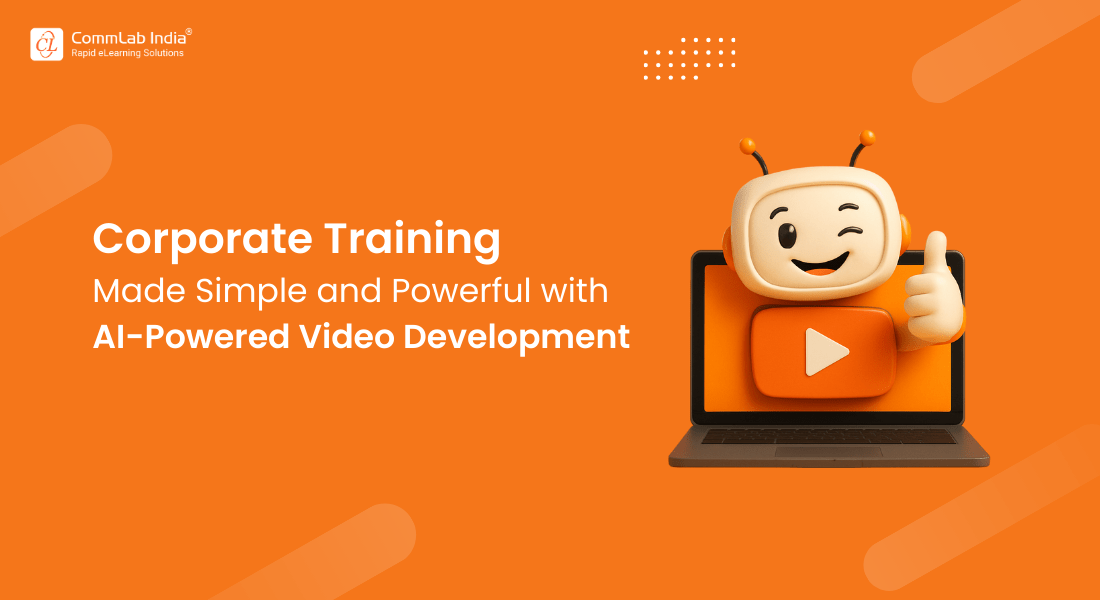2025 Corporate Training Trends: AI, Training Formats, and Business Results

Corporate training has never been more critical—or more complex. As organizations navigate economic shifts, hybrid workplaces, and accelerating skill demands, L&D professionals are reimagining how training is designed and delivered. One-size-fits-all no longer works. The future lies in purpose-driven training formats, powered by cutting-edge technologies like AI, agentic learning, and adaptive LMS platforms.
→ Download eBook: Corporate L&D Trends 2025 – Get the View from the Trenches
In this blog, we’ll explore:
- How to choose between in-person, online, and blended training formats
- How technology evolution is transforming business training
Not One-Size-Fits-All: In-Person, Online, and Blended Training
Effective corporate training must be tailored—not templated. What works for a global manufacturer may not suit a financial services firm. When building a training strategy, format matters. Different modes align with different content types, learner preferences, and organizational goals. Let’s explore the three most common approaches and real-world examples that demonstrate how each serves specific training needs.
I. In-Person Training: Deep Connection & Hands-On Learning
In-person training remains essential for leadership development, role-playing, and hands-on learning. It fosters deep connections, immediate feedback, and immersive group experiences—crucial for executives and frontline teams alike.
Instructor-led sessions make up about 66% of all corporate training, increasing to 76% in high-performing businesses and 80% in sectors like healthcare, finance, and utilities. Trainers can adapt in real time—addressing questions, interpreting body language, and adjusting delivery—while informal interactions boost networking and team cohesion.
According to the 2024 Training Industry Report by Training Magazine, classroom training still accounts for 35% of all training hours delivered. This traditional format demonstrates strong business impact in areas that require high interaction and nuanced communication.
It is evident that ILT (instructor-led training) is a powerful choice for programs where nuance, interaction, and discussion are key—such as leadership, compliance, and soft skills.
II. Online Training: Flexible, Scalable & Cost-Efficient
Online training excels in flexibility, scalability, and cost-efficiency—making it ideal for compliance modules, product knowledge, and digital upskilling across geographies. A staggering 90% of corporations offer digital learning, and over 40% of Fortune 500 companies use it at scale.
Employees complete eLearning 40–60% faster than classroom training and retain 25–60% more—compared to just 8–10% retention from in-person formats. The cost savings are impressive. Dow Chemical reduced training costs from $95 to $11 per learner, saving an estimated $34 million, while IBM saved $200 million, achieving a $30 productivity gain per dollar spent.
Learner preferences also support this shift:
- 70% prefer self-paced modules during work hours
- 58% favor flexible, on-demand learning
- 94% would stay longer at companies that invest in their career development
Thus, online training is not just convenient—it’s faster, more effective, and delivers measurable business results at scale.
Looking to make your online training more effective? Check out these 6 practical tips to get started!
III. Blended Learning: The Best of Both Worlds
Blended learning combines the efficiency of online learning with the engagement of in-person sessions, offering a powerful solution for hybrid workplaces.
For example, technical teams might learn theory through digital modules and then apply it during in-person workshops. This dual approach boosts comprehension and retention by allowing learners to access theory at their convenience and reinforce it through real-world practice.
Blended learning delivers clear advantages. A McKinsey study found organizations using blended methods saw a 30–40% higher ROI than those using a single mode. ATD reports a 50% boost in engagement and retention through blended strategies.
Real-world results include:
- Intel shortened a 12-day ILT course to a 5-day workshop plus 3 hours of online learning, cutting technician factory time by 60% and yielding a 157% ROI
- Temco reduced employee turnover through blended onboarding
- GE halved training time and saw a 10% improvement in service call handling
To design truly impactful corporate training programs, L&D professionals need a few smart strategies up their sleeve. First things first—take a close look at your existing training content. How deep does it go? How complex is it? Does it require real-time interaction? Answering these questions will help you figure out the best delivery format.
Next, break down your learner base. Not everyone learns the same way—so it helps to group employees by roles. For instance, your technical staff might need a different approach than leadership teams or frontline employees. Once you’ve segmented your audience, you can build a mix of modalities that actually works for each group.
And let’s not forget the tech. Investing in the right tools—like AI-powered platforms, smart Learning Management Systems (LMS), and high-quality video content—can really elevate the experience. These tools not only personalize learning but also give you valuable insights through data and analytics.
A good way to start? Pilot a blended learning model. It’s a low-risk way to test and refine your strategy before rolling it out across the organization. Just make sure you’re not measuring success only by course completions. Go beyond that. Look at whether employees are applying what they’ve learned on the job, if their performance is improving, and how training aligns with your business goals.
On a practical level, match your formats to your objectives. Choose in-person sessions when you need rich interaction, go digital when you need reach and flexibility, and use blended learning to get the best of both worlds. Use your LMS and mobile tools to prep learners before sessions and reinforce learning after they’re done. Think of it as a continuous journey—before, during, and after training.
And here’s the bottom line: there’s no single solution that works for everyone. The most effective training strategies are flexible and thoughtful. They combine different formats to meet the needs of your learners, the demands of your content, and your company’s big-picture goals. When you get that alignment right, you’ll see real improvements—not just in employee skills, but in overall business performance too.
The Tech Behind Corporate Training Evolution
What’s the Technology Driving the Evolution of Corporate Training?
- The Rise of Generative AI: Content, Context & Customization
- Agentic AI: Autonomous Learning Support
- AI-Infused LMS: Smart, Predictive & Adaptive
- Global Companies Leading the Way in AI-Powered Upskilling
- Linking Tech to Business Outcomes
In today’s digital-first workplace, technology powers every aspect of corporate training. What was once a support tool is now the engine of transformation—driven by AI, generative AI, and agentic AI.

1. The Rise of Generative AI: Content, Context & Customization
Generative AI is truly changing the game for L&D teams. What used to take weeks—like creating training videos, assessments, microlearning modules, or even full learning paths—can now be done in minutes.
Discover how AI is revolutionizing microlearning by making it smarter, faster, and more personalized than ever before.
Even better? It’s not just fast—it’s smart. Generative AI makes it possible to personalize training at scale, tailoring content based on each employee’s role, skill level, behavior, and performance data.
And the results speak for themselves. According to a 2023 McKinsey report, organizations that adopted generative AI cut their content development time by 40% and reduced costs by up to 30%. Even more impressive, employees reported greater satisfaction—thanks to training that was relevant, timely, and tailored to their needs.
2. Agentic AI: Autonomous Learning Support
Agentic AI isn’t just about creating content—it’s about taking action. Think of it as a smart digital coach or behind-the-scenes L&D assistant that works proactively to support your learners.
These AI agents can:
- Assign personalized learning paths
- Nudge employees to stay on track with their training
- Monitor engagement and flag when someone’s falling behind
- Even simulate coaching conversations or deliver real-time feedback
It’s like having a virtual learning concierge who knows what each learner needs—and delivers it at just the right moment. And this isn’t future-speak. According to Gartner (2024), over 50% of large enterprises will be using agentic AI by 2026 to streamline training delivery and make learning more personalized.

3. AI-Infused LMS: Smart, Predictive & Adaptive
Today’s Learning Management Systems (LMS) have come a long way. Platforms like Cornerstone, Docebo, and Workday Learning are no longer just digital filing cabinets—they’re intelligent, responsive, and deeply integrated with AI.
Here’s what modern, AI-powered LMS platforms bring to the table:
- Smart recommendations that adapt to each learner’s behavior and progress
- Predictive analytics that flag disengagement or skill gaps before they become problems
- Dynamic learning paths that guide learners based on goals, performance, and preferences
According to ATD’s 2024 State of the Industry report, a whopping 76% of best-in-class organizations are already using AI-enhanced LMS tools to boost learner engagement and maximize ROI.
Thus, your LMS can now do more than just deliver courses—it can actively shape learning journeys that are personalized, data-driven, and aligned with business goals.

Corporate L&D Trends 2025
Get the View from the Trenches
- Win with AI
- Design for the agile workforce
- Unlock scale, volume, quality
- Make an impact
- Much more
4. Global Companies Leading the Way in AI-Powered Upskilling
AI in learning and development isn’t just a trend—it’s already happening at scale. Some of the world’s biggest companies are leading the charge, using AI to upskill their workforces and boost performance.
- Accenture's GenAI Tutor: Accenture launched an on-demand Generative AI learning program, powered by content from Stanford Online, to equip business and technology leaders with real-time, interactive learning capabilities.
- Walmart’s AI-Driven Mobile Training: Walmart deployed AI-powered mobile learning tools for frontline employees, enabling just-in-time training and achieving a 10% increase in productivity.
- Amazon’s AI Ready Initiative: Amazon introduced its “AI Ready” program, aiming to provide free AI training to 2 million people worldwide by 2025 through new courses and scaled learning opportunities.
And it’s not just these giants—according to the 2024 LinkedIn Workplace Learning Report:
- 84% of L&D professionals believe AI will significantly shape their learning strategies in the coming years.
- 67% of organizations have already started investing in AI-powered learning technologies.
AI is no longer the future of corporate training—it’s the now. And companies that embrace it are already seeing the results.
5. Linking Tech to Business Outcomes
Let’s face it—corporate training doesn’t exist in a vacuum. It’s not just about checking boxes or delivering content. The real goal? Driving business results.
That’s where AI steps in as more than just a cool tool—it becomes a strategic powerhouse. When thoughtfully integrated into L&D programs, AI can have a direct and measurable impact on key business outcomes. Here's how:
|
L&D Outcome |
How AI Makes It Happen |
|
Faster time-to-competency |
Speeds up learning through automated content creation and adaptive learning paths |
|
Higher engagement |
Delivers personalized, just-in-time learning that fits seamlessly into daily workflows |
|
Improved retention |
Uses nudges, reminders, and AI coaching agents to reinforce and sustain learning |
|
Smarter decision-making |
Offers predictive insights through smart dashboards and learner analytics |
|
Scalable global training |
Enables automated content localization and seamless delivery across regions and roles |
These aren’t just incremental improvements—they’re game-changing efficiencies. When L&D teams align AI-powered training with real business needs, the impact goes far beyond the classroom (or LMS). You get faster upskilling, better engagement, more informed decisions, and scalable solutions that grow with your organization.
Bottom line? AI isn’t just a trend—it’s a results multiplier. And for L&D leaders focused on business performance, that’s a win worth investing in.
What’s Next?
As we head deeper into 2025, it’s clear that L&D leaders have an exciting opportunity—and a big responsibility. It’s time to rethink learning strategies with AI not as a replacement for humans, but as a powerful tool to amplify human potential.
The key isn’t just about using the latest tech for the sake of innovation. It’s about being intentional - matching the right training formats with the right content, audiences, and business goals. Whether it’s in-person for deeper connections, online for flexibility, or blended for the best of both worlds, every choice should support the bigger picture: building a smarter, stronger workforce.
The real win? When technology and training formats come together with purpose, L&D teams can create learning experiences that are not only scalable and personalized—but also deeply effective. That means employees who are more engaged, more capable, and more confident in their roles.
So, it’s not about choosing between formats or tools. It’s about creating the right mix—one that evolves with your people, your culture, and your business needs. The future of corporate training is here—and it’s adaptive, data-driven, and designed for impact.
Want to learn more? Download CommLab India’s eBook to explore emerging AI-based learning technologies, evolving learning strategies, and high-demand learning topics.






